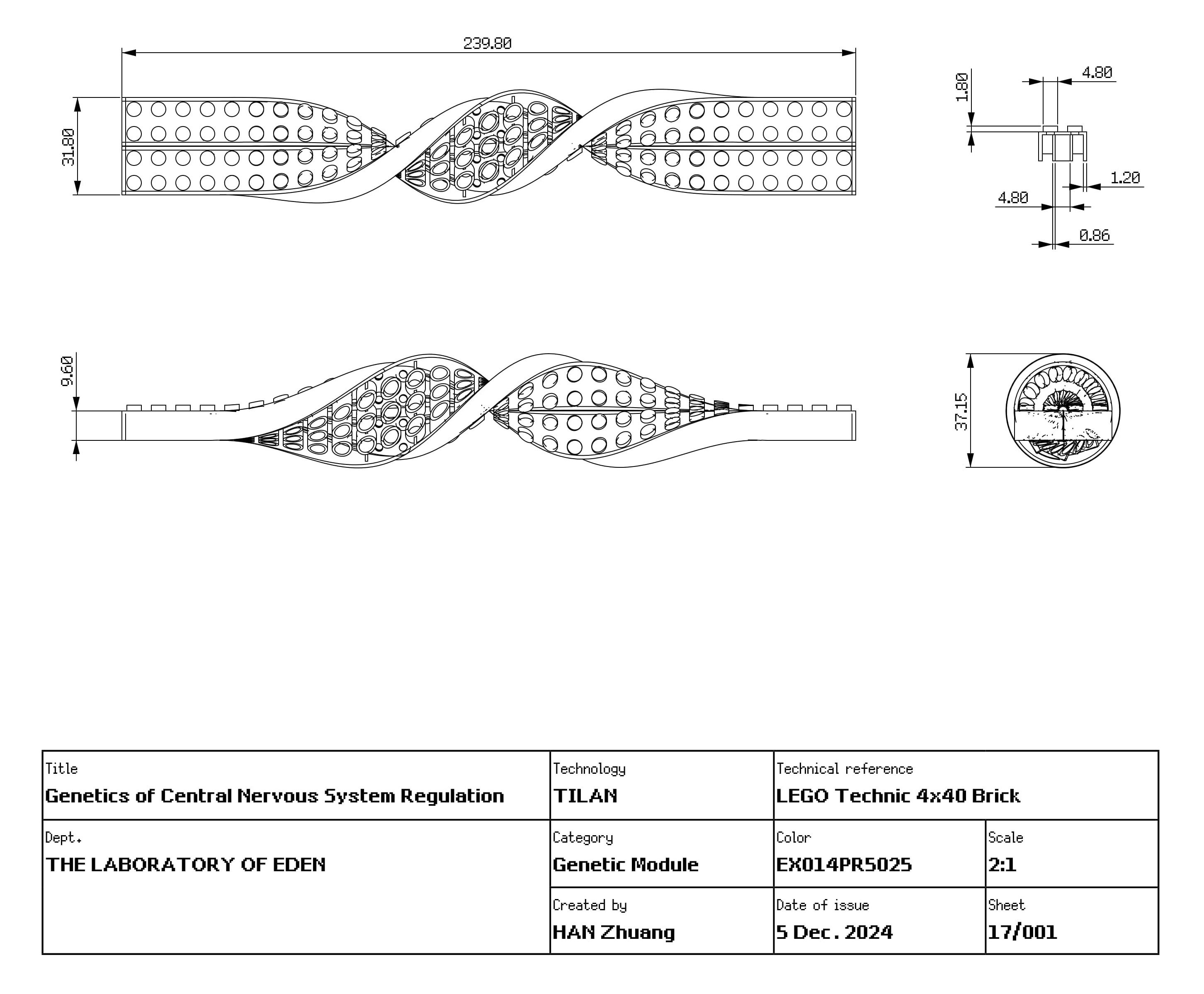Laboratory Background and Analysis
According to the Lab of Eden’s genetic and behavioral analysis, the client’s central nervous system (CNS) exhibits significant regulatory imbalances. This condition stems from a complex interplay between genetic factors and environmental stressors.
Laboratory studies indicate that frequent exposure to psychoactive substances in adulthood—including Δ9-tetrahydrocannabinol (THC) and other neuroactive compounds—has disrupted CNS signal transmission, impairing neurotransmitter functionality and further weakening the client’s neural connectivity with familial brain networks.
Additionally, the client’s genetic background has been profoundly influenced by parental traits. The father’s history of alcohol dependence and the mother’s chronic headaches may have contributed epigenetically to alterations in CNS development and regulation, shaping the client’s neurological stability and adaptive capacity.

Key Genetic Markers and Functions
| Genetic Marker | Genotype | Functional Description | Behavioral Manifestation |
|---|---|---|---|
| rs6265 | GG | BDNF gene : Regulates the expression of brain-derived neurotrophic factor (BDNF), influencing synaptic plasticity and neuronal regeneration. Low expression may result in reduced neural repair capacity. | Displays low BDNF levels, significantly impairing synaptic function and neuroregeneration. |
| rs4680 | AG | COMT gene : Regulates dopamine metabolism; variations may increase susceptibility to chemically induced mood fluctuations, leading to neural dysregulation. | Suggests moderate dopamine regulation sensitivity, elevating the risk of chemically induced mood instability and impaired stress regulation. |
| rs2832407 | TT | GABRA2 gene : Regulates alcohol metabolism efficiency; the father’s low metabolic efficiency genotype may genetically influence the client’s tolerance to alcohol exposure. | Indicates a risk of GABA receptor dysfunction, potentially leading to disrupted neural signal transmission. |
| rs2228622 | GA | ALDH2 gene : Regulates glutamate receptor function, involved in threat recognition and conflict resolution neural pathways. CT variant enhances contextual analysis and threat response efficiency. | Displays low alcohol metabolism efficiency, increasing inherited neural sensitivity due to paternal alcohol dependence. |
| rs3774873 | AA | TRPM8 gene : Regulates neural pathways related to temperature and pain perception. The mother’s hereditary predisposition to chronic headaches may be linked to high sensitivity expression of this gene. | Exhibits heightened sensitivity to pain and temperature fluctuations, likely correlated with the mother’s tendency for chronic headaches. |
Biological Parental Genetic Contribution
| Biological Parents | Key Genotype | Genetic and Environmental Interactions | Behavioral Manifestations |
|---|---|---|---|
| Biological Father | rs176123: AGC |
- rs4680: AG suggests moderate dopamine degradation efficiency; prolonged alcohol consumption behavior may epigenetically influence the client’s dopamine signal regulation.
- rs2228622: GA ind ic at es low a lcohol metabolism efficiency, making the client more susceptible to the effects of paternal alcoholism during childhood. |
Behavioral traits may have been shaped during early childhood through father-child interactions, influencing the client’s sensitivity to alcohol and external chemical substances. |
| Biological Mother | rs176123: AG |
- rs6265: GG suggests low BDNF levels, potentially inherited by the client, leading to insufficient neural repair capacity.
- rs3774873: AA indicates a heightened sensitivity to pain, consistent with the client’s strong reactions to environmental stimuli such as stress and temperature. |
The maternal genetic predisposition to chronic headaches may exert additional pressure on the client’s central nervous function through epigenetic regulation. |
Laboratory Model and Behavioral Manifestations
Exposure to Chemical Substances and Genetic Sensitivity
- The client’s central nervous system exhibits significant regulatory imbalance due to prolonged exposure to chemical substances, particularly affecting dopamine and GABA signal transmission.
Epigenetic Regulation
- The father’s alcoholism and the mother’s predisposition to headaches may, through epigenetic mechanisms, lower the client’s BDNF levels, weakening their neural recovery capacity and further reducing their connection to the family’s central nervous system network.
Behavioral Manifestations
- The client demonstrates heightened sensitivity to external stimuli (such as alcohol and psychoactive substances).
- Exhibits significant emotional fluctuations, potentially accompanied by behavioral dysregulation.
- Displays abnormal neural signal transmission under stressful conditions.
Laboratory Recommendations and Next-Life Parent Matching
| Matching Direction | Recommended Parental Traits | Genetic Optimization Goals |
|---|---|---|
| Next-Life Father Traits | Select a father carrying a low-activity variant of the COMT gene (e.g., rs4680: GG) to stabilize dopamine metabolism regulation. | Improves dopamine signal regulation and reduces emotional fluctuations. |
| Next-Life Mother Traits | Select a mother with lower sensitivity to temperature and pain in the TRPM8 gene (e.g., rs3774873: GG) to decrease hereditary pain sensitivity and environmental stress susceptibility. | Reduces hypersensitivity to external stimuli (such as temperature and pain), optimizing the adaptability of the nervous system. |
| Genetic Optimization Focus |
- Use TILAN technology to regulate BDNF gene expression, enhancing neural repair and synaptic plasticity.
- Adjust TRPM8 gene to reduce sensitivity to environmental stimuli. - Minimize the client’s exposure to alcohol and psychoactive substances. |
- Improves neural recovery capacity and enhances synaptic connectivity efficiency.
- Reduces neural signal abnormalities triggered by environmental stress, strengthening emotional stability and adaptability. - Provides training in neural function regulation and emotional management support to enhance resilience in stressful environments. |
Laboratory Conclusions and Research Directions
Laboratory Conclusions
- The client’s central nervous system genetic profile exhibits a high level of complexity, influenced by both parental genetic background and environmental factors. The father’s history of alcohol abuse has exerted profound effects on the client’s neural function through epigenetic mechanisms, while the mother’s hereditary predisposition to headaches has further intensified the client’s sensitivity to environmental stress. Through genetic analysis and optimization strategies, the laboratory aims to provide solutions for restoring neural balance and improving stress adaptability in the client’s next life.
Research Directions
- Investigate the long-term genetic impact of chemical exposure on dopamine system regulation and synaptic plasticity.
- Study the role of the TRPM8 gene in neural pain perception and stress regulation to develop potential genetic optimization strategies.